MetaIntegral is a global transdisciplinary design firm. We support visionary leaders, teams, and organizations to Be IMPACT. To do this we draw on and integrate a number of theories and their associated practices including: embodiment theory, design theory, integral theory, and developmental theory. As a result we help you thrive in complexity – transforming the world – from an embodied place of presence and purpose. We love to co-create with you – your events, products, services, books, business models, and business ecosystems among other things.
MetaImpact is the branch of MetaIntegral that is dedicated to the design of wisdom economies – which are accounting systems that integrate multiple types of impact, multiple forms of capital, and multiple bottom lines. This site is devoted to sharing with you our MetaImpact Framework, which lies at the heart of our approach to preserving the wholeness of individuals and systems.
“If you want to change reality – one powerful way is to change what you measure, how you measure it, and why you measure it. By measuring and making visible more of reality – we can then enter into a deeper dialogue with reality and thus cultivate greater forms of intimacy with it. To successfully navigate the complexity of the 21st century we need non-reductive and integrative ways of measuring impact and value exchange between individuals and systems.”
Sean Esbjorn-Hargens Ph.D.
MetaImpact Framework
At the heart of our approach is The MetaImpact Framework, which measures 4 Types of Impact with 10 Types of Capital which produce 4 Bottom Lines.
4 Types of Impact
10 Types of Capital
3 Types of Data
4 Bottom Lines
BE IMPACT
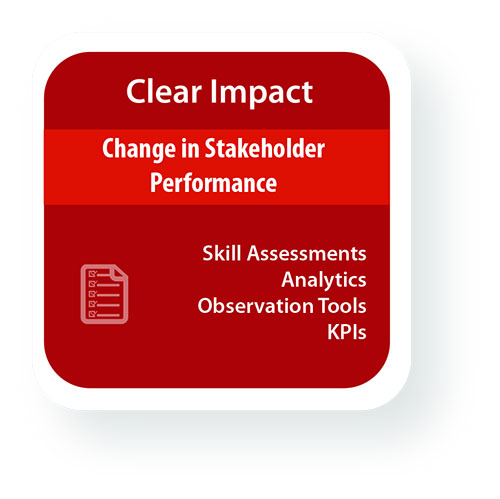
Clear Impact
One of the most common forms of impact is Clear Impact, which measures change in stakeholder performance. Many businesses and organizations include various metrics to assess this area of impact (e.g., skill assessments, analytics, observation tools, and various KPIs). What all these metrics have in common is the focus on objective criteria to track behavior and performance.
High Impact
The other main form of impact is High Impact, which measures change in stakeholder systems (e.g., supply chains, cash flow, customer engagement) . Many businesses and organizations include various metrics to assess this area of impact (e.g., environmental impact assessments, financial impact assessments, input indicators, and various KPIs). What all these metrics have in common is the focus on interobjective or systemic criteria to track organizational and market dynamics.
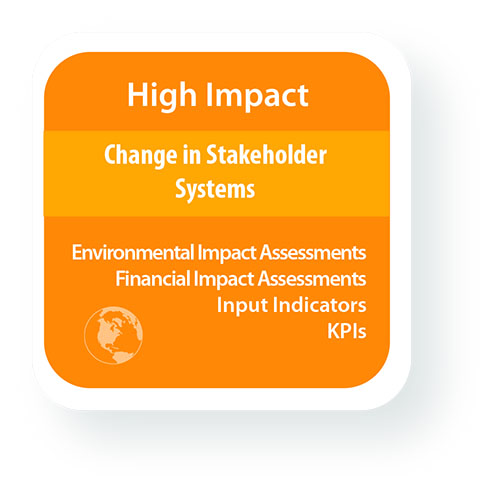
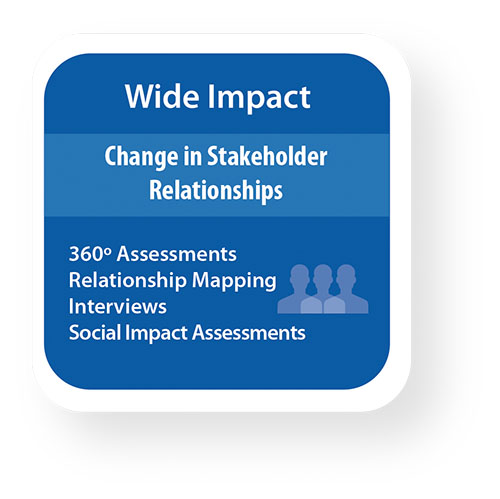
Wide Impact
Over the last decade it has become more common for organizations to include Wide Impact, which measures change in stakeholder relationships. With forms of network analysis and social mapping there have emerged various metrics to assess this area of impact (e.g., 360 Assessments, relationship mapping, interviews, and social impact assessments). What all these metrics have in common is the focus on intersubjective criteria to track the quality and quantity of relationships and their influence.
Deep Impact
Arguably, one of the most important forms of impact is Deep Impact, which measures change in stakeholder experience. There is a growing awareness among many businesses and organizations that this form of impact needs to be included. Various metrics are used to assess this area of impact (e.g., self-evaluations, psychometrics, satisfaction surveys, and happiness inventories). What all these metrics have in common is the focus on subjective criteria to track somatic, emotional, and psychological dimensions of experience.
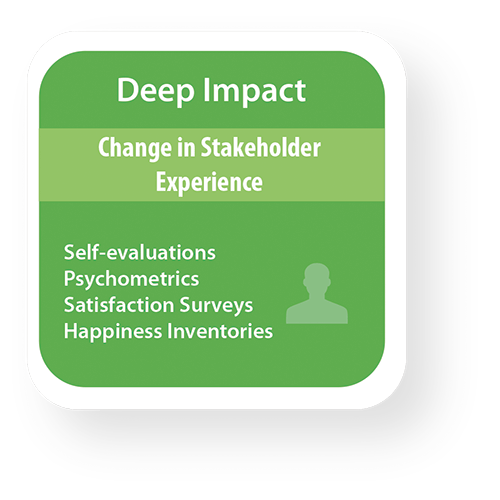
What is MetaImpact? Click to watch the video!
These four types of impact combine to create a comprehensive model of impact …
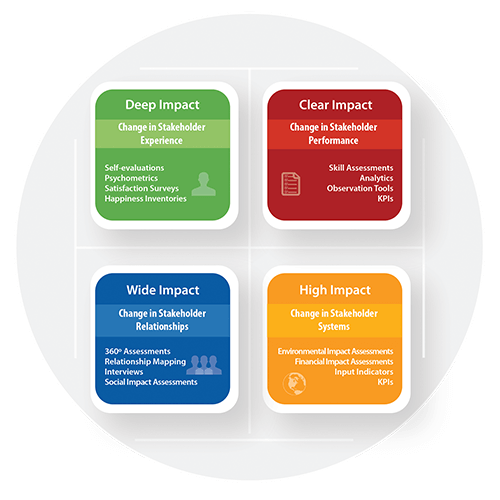
BE IMPACT
Why are there 10 capitals? Click to watch the video!
Over the last 30 years various individuals have created multiple capital frameworks which include anywhere between 3 and 20 different types of capital. We’ve done an integrative meta-analysis of over a dozen of these frameworks to identify what are the most important forms of capital to include in an expanded framework and how might we combine them into an elegant and intuitive framework – one that not only includes essential types of capital but highlights the different kinds of relationship between these capitals.
In 2011 the International Integrated Reporting Council (IIRC) began a multi-year global initiative to develop an expanded model of capital. Through their process they identified six types of capital that should be included in an integrated report. We have included all six of these in our model (they are identified with an asterisk after their name in our model). In addition to these six we have included four more that our analysis indicates are necessary for a comprehensive assessment of value creation. Then using Integral Theory we have organized these into four quadrants.
Keep in mind that …
• Not all 10 types of capital need to be used (sometimes it is just as powerful to be aware of what you are not including)
• All 10 types of capital have qualitative and quantative forms of measurement (i.e., 1st-person, 2nd-person, and 3rd-person methods)
• All 10 types of capital have formal and informal forms of measurement, which can be used to track and measure each type
BE IMPACT
There are three types of data for each of the 10 capitals. Together they form Integral Data. When they all are present then you have an integrative mixed-methods approach that combines qualitative and quantitative metrics to evaluate, track, and increase each form of capital.
What is Integral Data? Click to watch the video!



First-Person Data (1p)
Subjective methods such as self-report and self-awareness practices.
These are used to qualitatively study how people feel, think, and experience the world.
Often used by psychologists, somatic practitioners, poets, artists, meditators, and philosophers.
Plato’s Beauty
Habermas’ Truthfulness
Wilber’s Self
Second-Person Data (2p)
Intersubjective methods such as focus groups and interviews.
These are used to qualitatively study how people relate to and communicate with each other.
Often used by sociologists, action researchers, historians, linguists, marketers, and anthropologists.
Plato’s Good
Habermas’ Rightness
Wilber’s Culture
Third-Person Data (3p)
Objective methods such as observation and statistical analysis.
These are used to quantitatively study how people and systems behave and function.
Often used by behaviorists, doctors, scientists, economists, environmentalists, and engineers.
Plato’s True
Habermas’ Truth
Wilber’s Nature
BE IMPACT
Why are there 4 Bottom Lines? Click to watch the video!
The 10 Capitals and their forms of measurement combine into 4 Bottom Lines. These include the common triple bottom line of Profit, People, and Planet but also adds a 4th – Purpose. While a number of 4 bottom line models have been proposed – some of which even include Purpose as a fourth – our approach to having 4 bottom lines is distinct in at least two ways.
First, the common bottom lines of Profit, People, and Planet are often exclusively defined in terms of what we would call High Impact – with a focus on the systems involved. In contrast to this we redefine each of these bottom lines in a more holistic and integrative fashion – building on the important work of previous uses but avoiding a reductive approach to these bottom lines.
Second, we place the four bottom lines around our four quadrant model in a way that highlights specific relationships between the bottom lines. For example, each bottom line shares 2 or 3 forms of capital as part of its constitution. This enables an important form of integration between all four bottom lines.
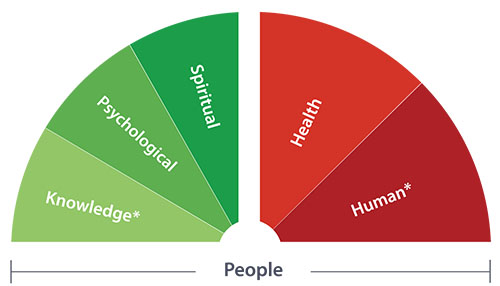
People
This bottom line focuses on the interior and exterior dimensions of human beings. It includes 5 capitals: Knowledge Capital, Psychological Capital, and Spiritual Capital for the interior aspects of individuals (and is associated with Deep Impact) and Health Capital and Human Capital for the exterior aspects of individuals (and is associated with Clear Impact). These five capitals capture the various forms of value associated with supporting human beings in their full multi-dimensionality: their rich interior life, their physical well-being, and their skills and behaviors.
Profit
This is the most common bottom line. In our model, it focuses on the exterior dimensions of both human beings and social and natural systems. It includes 5 capitals: Health Capital and Human Capital for the exterior aspects of individuals (and is associated with Clear Impact) and Manufactured Capital, Financial Capital, and Natural Capital for the exterior aspects of systems (and is associated with High Impact). These five capitals capture the various forms of value most commonly associated with employees and businesses. However, by adding physical well-being and the natural environment we expand the typical view of profit into a more holistic but still exterior focus.
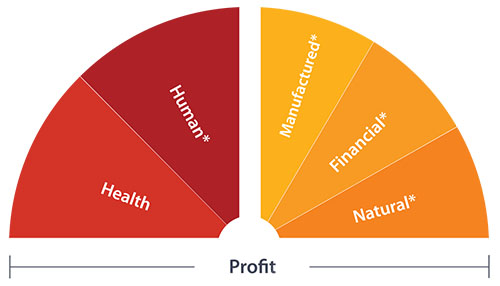
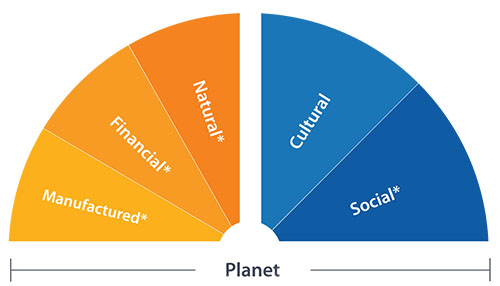
Planet
This bottom line focuses on the interior and exterior dimensions of the planet. It includes 5 capitals: Manufactured Capital, Financial Capital, and Natural Capital for the exterior aspects of social and natural systems (and is associated with High Impact) and Cultural Capital and Social Capital for the interior aspects of social and natural systems (and is associated with Wide Impact). These five capitals capture the various forms of value associated with supporting the planet and humanity as a whole: resource use and relational dimensions.
Purpose
This bottom line focuses on the interior dimensions of People and the Planet. It includes 5 capitals: Cultural Capital and Social Capital for the interior aspects of social and natural systems (and is associated with Wide Impact) and Knowledge Capital, Psychological Capital, and Spiritual Capital for the interior aspects of individuals (and is associated with Deep Impact). These five capitals capture the various forms of value associated with individuals and collectives cultivating purpose.
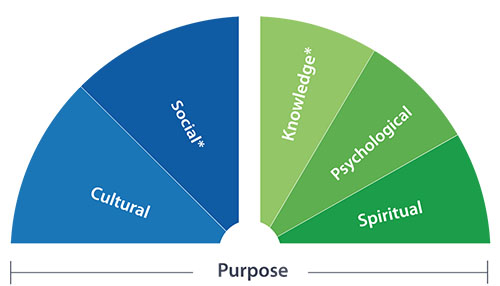
Together these 4 bottom lines combine to form the MetaImpact Framework.
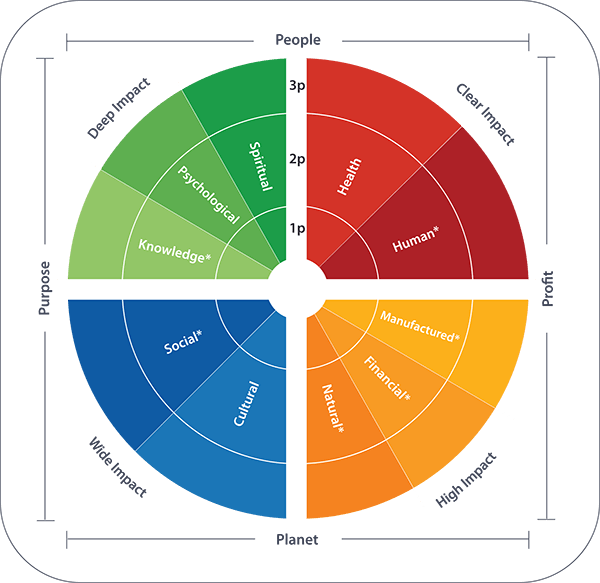
4 Types of Impact + 10 Types of Capital + 4 Bottom Lines =
a Wisdom Economy
